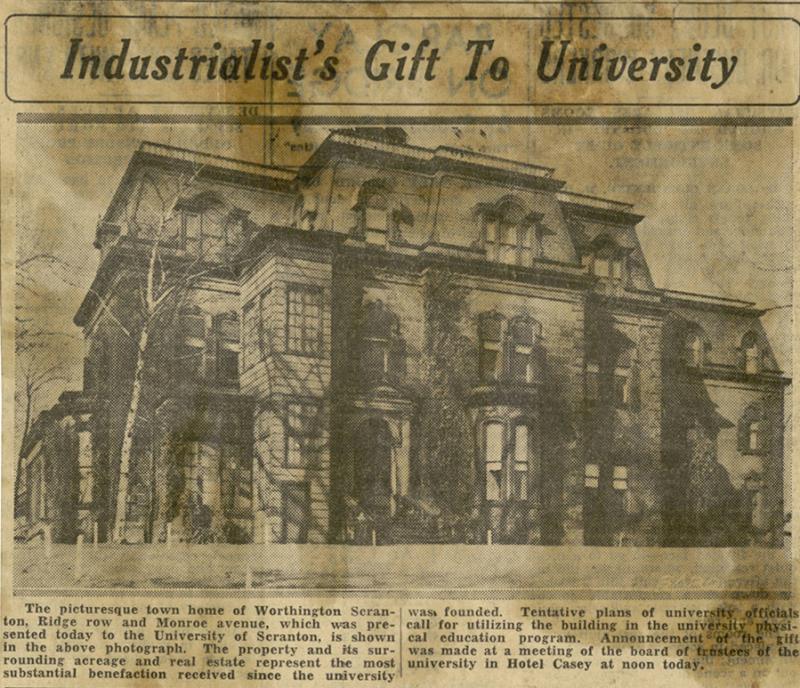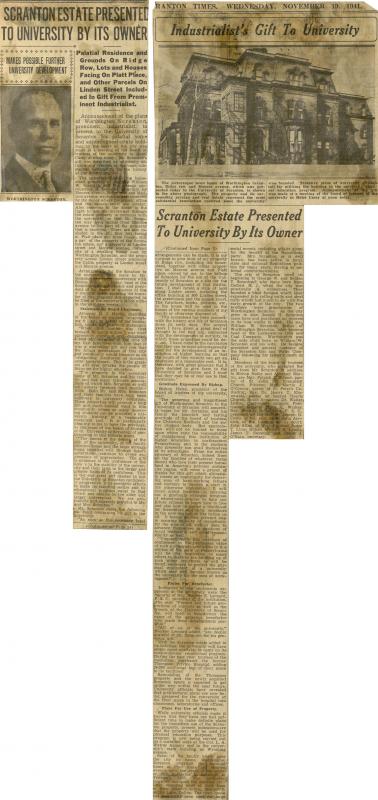Scranton Estate Presented to University by Owner, 1941
Item
- Title
- Date
- Source
- Record Identifier
- Exhibit Section
- Copyright
- Transcript
-
Scranton Estate Presented to University by Owner, 1941
-
1941-11-19
-
University of Scranton Archives
-
univscrapbook-b084_0052g
-
Times Shamrock Communications
-
[Please note that computer-generated transcripts include formatting, spelling, and grammatical irregularities and errors.]
SCRANTON TTMES. WEDNESDAY, NOVEMBER 19, 1941.
SCRANTON ESTATE PRESENTED TO UNIVERSITY BY ITS OWNER
MAKES POSSIBLE FURTHER UNIVERSITY DEVELOPMENT
Worthington Scranton
Palatial Residence and Grounds On Ridge Row, Lots and Houses Facing On PLatt Place, and Other Parcels On Linden Street Included In Gift From Prominent Industrialist.
Announcement of the plans of Worthington Scranton, prominent industrialist, to present to the University of Scranton his palatial home and adjoining real estate holdings in the heart of the city was made at a meeting of the board of trustees of the university in Hotel Casey at noon today. Mr. Scranton's gift was described by university officials and trustees as the most substantial benefaction in the history of the institution.
The premises include the homestead property of the late William W. Scranton and the acreage surrounding it, bounded generally by Monroe Avenue, Ridge Row and Madison Avenue, except the part reserved by the donor where his present office and the squash court are located. Also reserved to the donor is the right to use the driveways through the estate property in common with the university, so that Mr. Scranton may have access from Monroe avenue to his part of the property that is reserved. Then are also included in the gift: four lots facing on Platt place and three houses, still a part of the property of the Scranton estate, and a property at Linden street and Monroe avenue, former site of a dwelling house used by Worthington Scranton, and the property across Linden street adjoining the Catlin property at Linden street and Monroe avenue.
Arrangement for the donation to the University were made by Mr. Scranton at a recent conference with Bishop William Hafey, head of the Scranton Catholic diocese and president of the board of trustees of the University. Deeds covering the transfer of the property are expected to be filed at the recorder's office within the next few weeks.
Statement By Board Chairman.
Attorney M. J. Martin, chairman of the board of trustees, in accepting the gift on behalf of the institution, issued the following statement:
"When this matter was first brought to my attention I was most delighted. I told Mr. Scranton at the time of my first interview with him that it was a marvelous gift and one that the future generations of this city and community would treasure as an outstanding illustration of disinterested benevolence. This is the greatest gift ever offered the people of Scranton for higher education.
"The property is the ancestral home of Mr. Scranton and his family and has many intimate associations of which Mrs. Scranton as well will always treasure fond recollections. Both Mr. and Mrs. Scranton and their families have long been believers in university education. These properties will provide a long felt and much needed want in this community where so many deserving students can be provided a university training at a reasonably moderate cost. It is particularly
pleasing to me to have the privilege as chairman of the board of trustees of the University of Scranton, of participating in this historic event.
"The names of the donors, of the city, of the university, of the family mansion house and the large acreage being identical will, through future generations, continue to evoke expressions of appreciation. The gift
is evidence of the confidence of the donors in the stability of the university and their faith in the larger and greater fields of its usefulness. This is the one great gift needed to put the University of Scranton confidently progressive in its energetic efforts to make its standing secure and its educational program equal to that which one obtains in the older and larger universities. We are profoundly and sincerely grateful to Mr. and Mrs. Scranton."
Mr. Scranton made the following statement concerning his gift to the university:
"As soon as the necessary legal
Continued on-Page 24)
Industrialist's Gift to the University
The picturesque town home of Worthington Scranton, Ridge row and Monroe avenue, which was presented today to the University of Scranton, is shown in the above photograph. The property and its surrounding acreage and real estate represent the most substantial benefaction received since the university was founded. Tentative plans of university officials call for utilizing the building in the university physical education program. Announcement was made at a meeting of the board of trustees of the university in Hotel Casey at noon today.
Scranton Estate Presented To University By Its Owner
(Continued from Page 3)
arrangements can be made, it is my purpose to give most of my property at Ridge row, including the homestead, together with other properties on Monroe avenue and Piatt place, owned by me, to the bishop of Scranton for the use of the University of Scranton as a site for the future development of that institution. I shall retain a strip of land along Linden street, including the office building at 800 Linden street, the greenhouse and the squash court. The furniture, books, pictures, etc., in the house will be used in the homes of the various members of my family or otherwise disposed of.
"This homestead has been connected with the history and life of Scranton since its early days. For several years I have given a great deal of thought to the best use, connected with the development of our city, to which these properties could be devoted. I have come to the conclusion that they can be most advantageously used for the development of an institution of higher learning so that the youth of this vicinity can get an education at a reasonable cost. It is,
therefore, with great pleasure that I have decided to give them to the University of Scranton and I trust that they may be of real use to that institution."
Gratitude Expressed By Bishop.
Bishop Hafey, president of the board of trustees of the university, said:
"The generous and magnificent gift of Worthington Scranton to the University of Scranton will assuredly beget for Mr. Scranton and his family the heartfelt and lasting gratitude of the board of trustees, the Christian Brothers and the entire student body. But appreciation will not be limited to those upon whom rests the responsibility of maintaining this institution of higher education in northeastern Pennsylvania and to the students who presently can avail themselves
of its advantages. From the entire citizenry of Scranton. indeed from all the families of whatever racial decent who love their present homeland in America's premier anthracite region, will come a prayer of thanks for this gift which ultimately means an opportunity for deserving sons of hard-working fathers and mothers to receive a start in life otherwise impossible. It will mead added facilities in carrying out a gradually enlarged program of educational courses to help our future citizens to learn how to live and also how to insure a livelihood for themselves, and their neighbors
in the new day which lies before us all. It means another forward step in assuring equality of opportunity for the sons of all, rich or poor, to advance themselves to positions of social leadership and social responsibility as well.
"Unquestionably this evidence of confidence in the permanent value of such a collegiate institution in this section of the state of Pennsylvania will be the inspiration to many others to share in the building up of such other structures as will be found necessary to perfect the physical equipment of a university which may well become known as the university for the sons of working men."
Praise For Benefactor.
Indicative sentiments expressed at the time were the remarks of Rev. Brother E. Leonard, F. S. C. president of the institution, who said: "Present and future generations of students as well as the friends of the Universitv of Scranton, will hold in benediction the name of the generous benefactor who made these developments possible."
"All of us at the university," Brother Leonard added, "are deeply grateful of Mr. Scranton for his generous gift."
With the Scranton estate added to its holdings, the university will have ample space available to carry on its ever-widening educational program. During the past year, trustees of the institution purchased the former Thompson Private Hospital, adding 24,000 additional feet of floor space to its facilities.
Remodeling of the Thompson property and the newly acquired Scranton estate is expected to get under way within the near future. University officials have revealed that architectural plans are now being prepared for the conversion of the floor space in the hospital into classrooms, laboratories and offices.
Plans For Use of Property.
While university officials made it known that they have not had sufficient time to make definite plans for the immediate use of the Scranton property, present indications are that the property will be used for physical education purposes. This program is now being carried out on a curtailed scale at the Col. L. A. Watres Armory and in the university's main building on Wyoming avenue.
Scion of the family which gave the city its name, Worthington Scranton inherited the adjoining home at Platt place and Monroe avenue upon the death of his mother, Mrs. Katherine M. Scranton in February 1835. The Scrantons, however, occupied the mansion very little, spending most of their time a their country estate, Marworth, at Lily Lake, Dalton. The town house has frequently been used for large social events, including affairs given for the benefit of the Republican party. Mrs. Scranton, as is well known, has been active in local, state and national Republican politics for many years, serving as national committeewoman.
The city of Scranton owes its beginning to George W. and Seldon T. Scranton who came here from Oxford. N. J., when the city was practically a wilderness. They founded a blast furnace which later expanded into rolling mills and steel
mills which had much to do with the early growth of the city. The two brothers were grand uncles of Worthington Scranton. As the city grew in size. Joseph H. Scranton came here and purchased an interest in its iron works in 1858. His son, William W. Scranton, father of Worthington Scranton, later became head of the Lackawanna Iron and
Coal Company. Worthington was the only child born to William W. Scranton and his wife. He became president and general manager of the Scranton Gas and Water Company following his father's death in 1911.
Members of the board of trustees of the university, who accepted the gift from Mr. Scranton in addition to Bishop Hafey and Attorney Martin, are Mgr. Patrick J. Boland, pastor of St. John the Evangelist Church, Pittston; Mgr. Martin J.
O'Connor, pastor of St. Peter's Cathedral; Rev. Dr. Henry T. Klonowski, pastor of Sacred Hearts Church, South Scranton; Dr. Walter Loftus, Carbondale surgeon; Postmaster General Frank C. Walker; Rev. Brother E. Leonard, F.S.C., president of the college; Joseph G. Casey, of this city; Judge John Aponick, of the Luzerne county court; John Allan, of West Pittston; Judge T. Linus Hoban, William R. Lynett, James T. Sweeney and Frank J. O'Hara, secretary.
- Item sets

